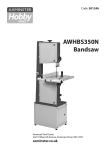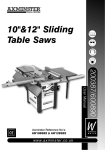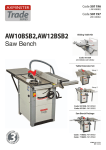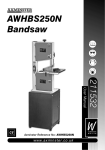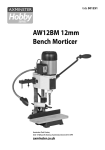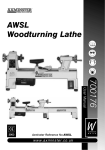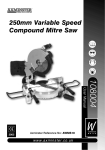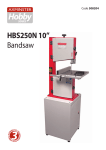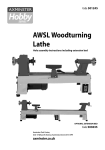Download Axminster AWHBS350N User manual
Transcript
AWHBS350N, AWHBS310N Floor Standing Bandsaw 211530 (AWBS350N) Axminster Reference No: AWHBS350N Axminster Reference No: AWHBS310N w w w. a x m i n s t e r. c o . u k 211530,211531 User Manual 211531 (AWBS310N) W AXMINSTER W H I T E Index of Contents... Page No. Index of Contents.................................................................................................................... 02 Declaration of Conformity………….………........……..………….........................................03 What’s in the Box………….………........……..…………...........................................................04 General Instructions for 240v Machines............................................................ 05-06 Unpacking.................................................................................................................06 Cabinet Assembly...........................................................................................07-08-09 Assembling the Bandsaw to the Cabinet................................................................ 10 Initial Assembly....................................................................................................11-12 Specifications….………........................................................................................................ 13 Identification and Description....................................................................... 14-17-19 Illustration and Parts Description ...................................................15-16-18-20-21-22-23 Setting Up the Saw................................................................................................... 24 Setting the Blade Guides......................................................................................... 25 Setting the Fence......................................................................................................26 Operating Instructions………........……..…………........................................................ 27-28 Changing the Saw Blade........................................................................................................ 28 Routine Maintenance.............................................................................................................. 29 Parts Breakdown Drawing...................................................................................30-33 Parts List....................................................................................................31-32-34-35 Cabinet Parts Breakdown & List..............................................................................36 Notes.............................................................................................................. 37-38-39 Saf sp irator Re Sa Two E R Ey y Helm fet Safety Protection Symbols r fety Viso Sa et st Mask Du F ootw ety r ea tiv e Glo tec s ve Def ende rs ar bly m n Asse Ma ro tectio eP n AXMINSTER W H I T E al W d Manu ea Pro ! The symbols shown on the cover of this manual advise that you wear the correct safety protection when using this machine. SAFETY!! Declaration of Conformity... W AXMINSTER W H I T E Copied from CE Certificate The undersigned, F. Mocking authorised by Laizhou City Fulin Electric Co., Ltd. No. 275 Wenquan East Road Laizhou, Shandong 261400 P.R. China declares that this product: Bandsaw MJ343B, MJ343C manufactured by Laizhou City Fulin Electric Co. is in compliance with the following standards or standardisation documents in accordance with Council Directives EN 55014-1:2000 EN 61000-3-2:2000 EN 61000-3-3:1995+A1 EN 55014-2:1997 FREEPHONE 0800 371822 03 W What’s in the Box... AXMINSTER W H I T E Model Numbers: MJ343B (211530) MJ343C (211531) 1 No. Bandsaw 1 No. Bandsaw Blade (211530) 2480mm long 4 TPI Skip assembled in the saw...(not tensioned) 1 No. Bandsaw Blade (211531) 2270mm long 4 TPI Skip assembled in the saw...(not tensioned) 1 No. Saw Table 1 No. Fence Guide & Extension 1 No. Mitre Guide 1 No. Packet containing the On/Off Switch Safety Shroud 1 No. Table Insert Floor Cabinet comprising:2 No. Top Supporting Plate 2 No. Top Connecting Plate 2 No. Side Connecting Plate 2 No. Side Plate 4 No. Rubber Feet Plastic Bag Containing: 24 No. M6 x 12 Hex Bolt 24 No. M6 Hex Nut 48 No. M6 Washer 4 No. M8 x 40 Bolts & M8 washers 1 No. Instruction Manual 1 No. Guarantee Card Having unpacked your accessories(see overleaf) please dispose of any unwanted packaging properly. The cardboard packaging is biodegradable. ! Please read the Instruction Manual prior to using your new machine; as well as the operating procedures for your new machine, there are numerous hints and tips to help you to use the machine safely and to maintain its efficiency and prolong its life. Keep this Instruction Manual readily accessible for any others who may also be required to use the machine. 04 www.axminster.co.uk General Instructions for 240v Machines... W AXMINSTER W H I T E Good Working Practices/Safety The following suggestions will enable you to observe good working practices, keep yourself and fellow workers safe and maintain your tools and equipment in good working order. ! WARNING!! KEEP TOOLS AND EQUIPMENT OUT OF THE REACH OF YOUNG CHILDREN General Advice Mains Powered Tools Primary Precautions These machines are supplied with a moulded 13 Amp. plug and 3 core power cable. Before using the machine inspect the cable and the plug to make sure that neither are damaged. If any damage is visible have the tool inspected/repaired by a suitably qualified person. If it is necessary to replace the plug, it is preferable to use an ‘unbreakable’ type that will resist damage on site. Only use a 13 Amp plug, and make sure the cable clamp is tightened securely. Fuse as required. If extension leads are to be used, carry out the same safety checks on them, and ensure that they are correctly rated to safely supply the current that is required for your machine. Work Place/Environment Make sure when the machine is placed that it sits firmly on the floor, that it does not rock, that it is sufficiently clear of adjacent obstacles so that cutting operations will not be impeded. Check you have adequate clearance both in front of, and behind the machine when cutting long stuff. If you are liable to be processing unwieldy or awkward work pieces, it is suggested that you consider fastening the machine down to the floor. The machine is not designed for sub-aqua operation, do not use when or where it is liable to get wet. If the machine is set up in the open, and it starts to rain (unusual though this would be in U.K.), cover it up or move it into the dry. If machine has got wet; dry it off as soon as possible, with a cloth or paper towel. Do not use 240Va.c. powered machines anywhere within a site area that is flooded or puddled, and do not trail extension cables across wet areas. Keep the machines clean; it will enable you to more easily see any damage that may have occurred. Clean the machine with a damp soapy cloth if needs be, do not use any solvents or cleaners, as these may cause damage to any plastic parts or to the electrical components. Keep the work area as uncluttered as is practical, this includes personnel as well as material. FREEPHONE 0800 371822 05 W General Instructions for 240v Machines... AXMINSTER W H I T E ! (Under no circumstances should CHILDREN be allowed in work areas). It is good practice to leave the machine unplugged until work is about to commence, also make sure to unplug the machine when it is not in use, or unattended. Always disconnect by pulling on the plug body and not the cable. Once you are ready to commence work, remove all tools used in the setting operations (if any) and place safely out of the way. Re-connect the machine. Carry out a final “tightness” check e.g. guide fence, table tilt, etc.., check that the ‘cutting path’ (in this case; the path that the work piece will travel) is unobstructed. Make sure you are comfortable before you start work, balanced, not reaching etc.. If the work you are carrying out is liable to generate flying grit, dust or chips, wear the appropriate safety clothing, goggles, gloves, masks etc., and if the work operation appears to be excessively noisy, wear ear-defenders. If you wear your hair in a long style, wearing a cap, safety helmet, hairnet, even a sweatband, will minimise the possibility of your hair being caught up in the rotating parts of the tool, likewise, consideration should be given to the removal of rings and wristwatches, if these are liable to be a ‘snag’ hazard. Consideration should also be given to non-slip footwear, etc.. Do not work with cutting tools of any description if you are tired, your attention is wandering or you are being subjected to distraction. A deep cut, a lost fingertip or worse; is not worth it! Do not use this machine within the designated safety areas of flammable liquid stores or in areas where there may be volatile gases. There are very expensive, very specialised machines for working in these areas, THIS IS NOT ONE OF THEM. Check that blades are the correct type and size, are undamaged and are kept clean and sharp, this will maintain their operating performance and lessen the loading on the machine. Above all, OBSERVE…. make sure you know what is happening around you, and USE YOUR COMMON SENSE. Unpacking... Your saw is packed in the box partially assembled. Unfortunately this is more of an exercise to ensure that the components are inserted in the correct positions than a shortening of the build time. e.g. the blade is fitted, the securing bolt for the tilt mechanism is inserted in the tilt quadrant with the washer and the locking butterfly nut threaded on to the bolt, etc. Please make careful note of the positions of the various components if you have cause to disassemble, whilst putting the machine together. Take all the easily removable items out of the box, tip the box up so that the base of the saw is to the ground, remove all the polystyrene packaging from around the saw (open both sides of the box?) then “corner walk” the saw out of the box. If this is still awkward, split the top of the box, fold the box material flat on the floor, and “wriggle” the saw off the cardboard. (The best method of moving the saw is with a ‘hug’ lift through the neck of the saw, holding the saw back against your body and lifting by straightening your legs). 06 www.axminster.co.uk Cabinet Assembly... W AXMINSTER W H I T E Step 1 Support plate Base M6 x 12 bolts and washers. Step 2 Attach the two connecting plates. Lightly tighten the M6 x 12 bolts and washers. FREEPHONE 0800 371822 07 W Cabinet Assembly... AXMINSTER W H I T E Cabinet door Step 3 Place the door between the support & connecting plates & insert the two spring hinge pins into pre-drilled holes. Spring hinge pin. Step 4 Side plate Locate the side plate and lightly secure using M6 x 12 bolts & washers. 08 Support plate Locate and secure the other support plate. www.axminster.co.uk Cabinet Assembly... W AXMINSTER W H I T E Step 5 Attaching the rubber foot to the base of the cabinet Screw the four rubber feet into each corner to the base of the cabinet Step 6 Tighten all the M6 x 12 nuts, bolts and washers before mounting the bandsaw. FREEPHONE 0800 371822 09 W Assembling the Bandsaw to the Cabinet.... AXMINSTER W H I T E Lift the saw on to the cabinet, and secure using the 4 M8x40 bolts nuts and washers. ( Insert the bolts through the base of the saw, through the floor cabinet and fit the washers and nuts on the underside). ! When mounting the unit, we strongly advise you get the assistance of another person because of the weight of the machine. WARNING Bandsaw M8x40 bolt & washers Cabinet 10 Please Note: the Illustration above shows the AWHBS350N & the table already assembled to the bandsaw for clarity. Initial Assembly... W AXMINSTER W H I T E Mounting the saw table The saw table can be fitted without removing the blade, however, if you would feel more comfortable not having to manoeuvre the table around the blade (the table is quite heavy), remove the blade by opening the top and bottom covers, release the tension on the blade by backing off the tensioning wheel Fig 1 Remove the fence rail and put safely aside Fig 3 Fig 2 Remove the table stabilising bolt & table insert Fig 3a Remove the butterfly bolt & washer beneath the table, slide the blade through the table slot & lower the table, guiding the threaded bolt through the hole in the tilt quadrent housing. Fig 4 Replace the butterfly bolt & washer you removed earlier, and tighten. Fig 5 Replace the table stabilising bolt and re-attach fence rail. Replace the table insert. 11 W AXMINSTER W H I T E Initial Assembly... Fitting the guide fence & NVR Switch Fit the guide fence by clipping the rear clamp over the back rail first and dropping the front clamp over the fence rail. (See fig 6) Push down on the lock lever, and ensure the fence clamps up correctly. (See fig 6a). Check the guide fence is set parallel to the blade. Any slight discrepancy can be taken out by loosening the 4 No. butterfly bolts that secure the blade of the guide fence to the clamping body, adjust and re-tighten. Larger discrepancies may require that the fence rail is angled slightly. The dimensioning scales have adjustable index plates set in the fence guide front clamp body to enable the scales to be zero read. (See fig 6c) Fig 6 Fig 6a Fence rail Guide fence Lock lever Fig 6b Fig 6c Magnifying glass Guide bearing Dimensioning scale Fig 7 Fig 7a Switch shroud 12 Remove the two phillips screws from either side of the switch assembly, see fig 7, slide the switch shroud over the switch, see fig 7a and secure using the two phillips screws you removed earlier. Specification... W AXMINSTER W H I T E Axminster No. 211530 (AWHBS350N) Rating: Trade Motor: 240v 50Hz 750W 1400rpm Blade Speed (Off Load): 600 & 720m/min Blade Length: 2480mm Blade Size, Min/Max: 6mm (1/4") to 16mm (5/8") Table size: 500 x 400mm Table Tilt: minus 5 to + 45˚ degrees Table Height on Bench: 570mm Table Height on Stand: 1065mm Max Cutting Depth: 200mm Max Cutting Width: 335mm Max Cutting Width with Fence: 225mm Dust Extraction Outlet: 100mm Overall Size L x W x H: 760 x 720 x 1700mm Weight: 90kg Axminster No. 211531 (AWHBS310N) Rating: Light Trade Motor: 240v 50Hz 550W 1400rpm Blade Speed (Off Load): 360 & 720m/min Blade Length: 2270mm Blade Size, Min/Max: 6mm (1/4") to 16mm (5/8") Table size: 500 x 400mm Table Tilt: minus 5 to + 45˚ degrees Table Height on Bench: 480mm Table Height on Stand: 1050mm Max Cutting Depth: 180mm Max Cutting Width: 300mm Max Cutting Width with Fence: 225mm Dust Extraction Outlet: 100mm Overall Size L x W x H: 710 x 675 x 1075mm Weight: 80kg FREEPHONE 0800 371822 13 W Identification and Description... AXMINSTER W H I T E Main saw frame The main body of the machine that all the other parts are mounted upon. Upper and lower The two doors that cover the upper and lower saw wheel compartments. cover doors There are interlocks fitted to both doors so that the machine cannot operate if either door is left open. Upper saw wheel The upper saw wheel is mounted on double bearings on an axle that is mounted to a tilting plate. (To provide the fore and aft tilt movement that controls the blade tracking). The tilting plate is hinged to a base plate that is mounted in slides in the upper saw wheel compartment. (The base plate slides up and down allowing increasing or decreasing of the blade tension). The saw wheel is fitted with a rubber tyre to give better grip to the saw blade, and smoother running. It also allows the blade to be tracked in the centre of the wheel; unlike the bad old days when the blade had to be tracked off the front edge of the wheel to safeguard the teeth. Blade tensioning The blade tensioning wheel, at the top of the machine, is connected wheel to a threaded rod that is engaged in the base plate of the upper saw wheel axle assembly. The threaded rod is anchored in the top of the saw frame which allows the base frame to be driven up and down in its mounting slides and tension or de-tension the blade. 14 Upper blade guide and guard The upper blade guide assembly mounts the two side bearings and the rear thrust bearing that keep the blade stable (straight and untwisted) above the table during the sawing operation. The guard is an integral part of the guide mounting leg to which the guide assembly is bolted so it is always in place when the guide is raised or lowered to its working position. Upper blade guide height clamp The upper blade guide height clamp is a butterfly nut and coach bolt arrangement that clamp through the guide mounting leg and the main saw frame. So, loose it will allow the mounting guide leg to be moved up and down, tightened it will clamp the leg in position against the frame. Saw table, tilt assembly and scale The saw table is mounted on the tilt quadrant, which is, in turn mounted in the quadrant housing and secured via a coach bolt and butterfly nut arrangement. Loosening the butterfly nut allows the table to be tilted up to 45 degrees clockwise. There is an adjustable bolt with a lock nut, screwed into the underside of the table, which acts as a pre-set stop when bringing the table back to the level position. There is a scale and pointer attached to the rear of the quadrant and the housing to measure the angle to which the table has been tilted. There are two slots machined in the table to accept the slide of the mitre fence. www.axminster.co.uk Illustration and Parts Description... W AXMINSTER W H I T E 211530 (AWHBS350N) Blade tensioning wheel Upper cover door Fig 8 Upper cover door latches Upper blade guide height clamp Main saw frame Upper blade guide and guard On/Off button and switch shroud Saw table insert Mitre fence Guide fence Lock lever Fence guide rail Lower cover door Idler wheel adjusting knob Switch shroud Dust extraction outlet Lower cover door latch On/Off buttons Fig 8a Floor cabinet 15 W Illustration and Parts Description... AXMINSTER W H I T E 211531 (AWHBS310N) Upper cover door Blade tensioning wheel Fig 9 Upper cover door latches Upper blade guide height clamp Main saw frame Upper blade guide and guard On/Off button and switch shroud Saw table insert Mitre fence Guide fence Lock lever Fence guide rail Lower cover door Idler wheel adjusting knob Switch shroud Dust extraction outlet Lower cover door latch On/Off buttons Fig 9c 16 Floor cabinet Identification and Description... W AXMINSTER W H I T E Saw table insert The saw table insert fits into the round recessed groove in the centre of the table. It not only fills the round void, it also supports the workpiece below the saw in order to minimise ‘breakout’ from the sawcut. The table insert that is supplied is for general work, and woods and white woods to be carried through by the saw blade. Alternative table inserts should be made when carrying out very fine work, where the breakout must be kept to a minimum. Lower blade guide and guard The lower blade guide assembly is mounted on the main saw frame below the table, it mounts the rear thrust bearing and two side guides that keep the blade stable (straight and untwisted) below the table during the sawing operation. The lower guard is two half red plastic enclosures that screws to the guide assembly, and shields the blade between the underside of the table and the top of the lower saw wheel compartment. Fence guide rail The fence guide rail is a metal extrusion that is bolted onto the saw table with 4 butterfly bolts and washers. The fixing locations in the guide rail are slots, which allow the angle of incidence between the table and the guide rail to be adjusted; to enable the guide fence to be set square to the table. There is a ruler scale set in the guide rail to aid the setting of the guide fence. NOTE. The guide fence rail should always be fitted and securely fastened to the saw table, even if it is not properly set up for the fence. This is to help maintain the stability of the saw table in the area of the slot which is cut through the table to allow the blades to be fitted. Upper blade guide height adjusting knob The inner edge of the upper guide assembly is toothed to form a rack. The pinion part of this mechanism is on the end of the shaft connected to the blade guide adjusting knob. Turning the knob will allow the guide assembly to be raised or lowered (provided the clamp is loosened). Guide fence An extruded aluminium assembly primarily consisting of the main mounting body and the blade. The blade is bolted to the top of the main body. The main body is shaped to fit over the fence rail and mounts the clamping handle. The clamping handle is attached to a torsion bar which is fed through the blade of the guide and acts on the rear clamp, pulling it tight against the back rail through the lever action of the clamp handle. There is a fixed measurement scale mounted on the fence rail. On each side of the main body is an aperture through which this scale can be read. Mounted in each aperture is an adjustable index, to enable the measurements to be zeroed. Mitre fence The mitre fence slide can be engaged in either of the slots in the saw table, and acts as an X-feed device, which will enable any angle from 0 to 45 degrees left or right to be cut with the saw. FREEPHONE 0800 371822 17 W Illustration and Parts Description... AXMINSTER W H I T E Blade tensioning wheel Tracking control knob Upper blade guide height adjusting wheel Guide fence Mitre fence Saw table Tilt quadrant Quadrant housing Tilt mechanism clamp Idler wheel adjusting knob Motor Dust extraction outlet 18 Fig 10 Identification and Description... W AXMINSTER W H I T E Back rail An aluminium extrusion bolted to the rear of the saw table, that is used as the rear clamp bracket for the guide fence. Tracking control The tracking control wheel, at the rear of the top compartment, is wheel connected to a threaded rod that is engaged in a threaded hole in the base plate of the upper saw wheel axle assembly. The end of the rod pushes against the lower end of the hinged tilting plate that carries the upper saw wheel axle. Driving the rod in or out will cause the plate to tilt, and by association, the upper saw wheel, thus enabling the blade to be ‘tracked’. The tilting plate is kept in contact with the end of the threaded rod by the tension on the saw blade, (the downward ‘pull’). It should be self - evident therefore, that the blade can only be ‘tracked’ whilst it is in tension. Lower saw wheel The lower saw wheel and integral pulley wheel is likewise mounted on double bearings, onto an axle that is mounted to a fixed base plate. The base plate, triangular in shape, is bolted to the rear face of the lower saw wheel compartment. There are no adjustment mechanisms for the lower saw wheel. Mounted on a fixed shaft on a fixed base it is the base parameter that the rest of the saw is set against. Drive belt tensioning idler wheel The drive belt tensioning idler wheel (the idler), is mounted on a stub axle assembly that is captive in a slotted base plate. The idler wheel adjusting knob, on the side of the lower saw wheel compartment, is connected to a threaded rod which is engaged in the stub axle assembly. The rod is anchored in the side of the main saw frame, so that turning the knob will drive the stub axle assembly back and forth along the slot in the base plate. This allows the drive belt to be tensioned, or the tension removed to allow the belt to be changed or moved to the alternate groove to change the speed. Remember; the belt is tensioned by ‘pushing’ the idler forward against the belt, not ‘pulling’ the idler back against the belt. Dust extraction outlet A 98mm diameter dust extraction outlet. On/Off Button and switch shroud The On/Off buttons, fitted with the optional shroud, (see the initial assembly instructions). FREEPHONE 0800 371822 19 W Identification and Description... AXMINSTER W H I T E 211530 (AWHBS350N) Blade tensioning wheel Fig 11a Fig 11b Upper wheel mounting assembly Upper saw wheel Upper blade guide height mechanism Upper blade guide height clamp Fig 11b Lower saw wheel Micro switch Idler wheel adjusting knob Fig 11c 20 Fig 11 Drive belt tensioning idler wheel Main Heading... W AXMINSTER W H I T E 211531 (AWHBS310N) Fig 12 Fig 12b Drive belt tensioning idler wheel Lower saw wheel Fig 12a 21 W Identification and Description... AXMINSTER W H I T E Fig 13a Tilt quadrant Fig 13 Saw table Scale Tilt scale pointer Tilt mechanism clamp Quadrant housing Fig 14 Unlock Lock 22 Table preset level stop Identification and Description... W AXMINSTER W H I T E Fig 13a Saw table insert Mitre scale Mitre fence Fig 15 Typ. 2‘T’ Slot Pointer Fig 16 Upper blade guide height clamp Upper door latch 23 W Setting Up the Saw... AXMINSTER W H I T E ! DISCONNECT THE SAW FROM THE MAINS SUPPLY Tensioning and tracking the blade Make sure both top and bottom blade guides are well clear of the blade. Open the front covers fully, giving good access to the top compartment of the saw and good visibility into the bottom compartment (see figs 11 & 12). Check that the blade is sitting approximately in the middle of the wheels. Apply some tension to the blade by turning the tensioning wheel clockwise, spin the top wheel and check that the blade remains centrally on the tyre, if it does not, adjust the tracking by turning the tracking control at the rear of the head box (see fig 10). (Viewed directly onto the tracking control wheel, turning clockwise should cause the blade to track to the rear of the tyre, anti-clockwise to the front, DO NOT make large adjustments). Spin the top wheel again, check again. Continue until the blade tracks in the centre of the tyres with no appreciable to and fro movement. Tension the blade fully. (A sideways push of about 7-8 lbs(3+kgs) in the middle of the blade should allow a 1 / 4 ",(6.5mm) distension). Check the tracking again, adjust if necessary. Check that the drive belt is tensioned correctly, if it is slack, apply ‘take up’ pressure to the belt by adjusting the ‘idler’ pulley, using the knob at the side of the machine.(See figs 11c & 12b). Connect the power to the machine. Stand clear and start the saw, check that the saw is running smoothly, (no thumps, bumps, knocking or excessive vibration) and the blade appears to be tracking correctly (in one place). You can check this by holding a marker, e.g. a pencil, close to the back of the blade (approach from the back of the blade only) and check that the gap remains constant. If it doesn’t, adjust the tracking until it does. (If you adjust the tracking with the saw running, make very small adjustments and wait for the saw to react before you adjust again, sometimes the reaction is not instantaneous). Once you are satisfied that the tracking is correct switch the machine off and allow it to run to a stop. ! DISCONNECT THE SAW FROM THE MAINS SUPPLY Checking the table is square Loosen the butterfly nut clamping the tilt mechanism, and turn the table hard against its stop. (This is a bolt with a lock nut screwed into the underside of the table, (See figs 13 & 13a), the head of the bolt acts as a stop when it strikes the machine frame). Tighten the butterfly nut. Make sure the upper blade guide is raised as high as possible. Place a square on the table and move it up against the blade (behind the teeth). Check that the blade is perpendicular to the table. If it is not, try resetting the table. If it is still not correct, loosen the locking nut and adjust the bolt until perpendicularity is achieved, tighten the lock nut and then re-check. When you are satisfied that the table is set correctly, check that the pointer of the tilt gauge reads zero, if not, adjust it. 24 Setting the Blade Guides... W AXMINSTER W H I T E ! DISCONNECT THE SAW FROM THE MAINS SUPPLY Lower the upper blade guide to approximately 1 1/2"(38mm) above the table. Clamp in place. NOTE: The table has been removed for clarity. Loosen the bolt holding the guide assembly in place (A) and adjust the back to front position so that the leading edges of the side guide bearings are approximately 1.5 mm behind the gullets of the saw blade. Re-tighten the bolt. Loosen the cap head bolt that clamps the rear thrust bearing in position (B) and adjust the thrust bearing to approximately 1mm behind the blade, re-tighten the bolt. Loosen the two cap head bolts holding the guide bearings (C) and move to approximately 0.5 mm from each side of the blade. Re-tighten the bolts. Gently push the blade back against the thrust bearing (use a scrap of wood,) and check that the side bearings are still behind the teeth of the blade. Beneath the table, loosen the the two cap head bolts holding the lower blade guide assembly in place and position similarly to the upper guide assembly. Re-tighten the bolts. Adjust the lower blade guides, and set them similarly to the upper guides, (D) using an allen key to release and tighten the clamping bolts. When all adjustments have been made, recheck that when the blade is pressed back against the thrust bearing, both the upper and lower side guides are still behind the teeth of the saw replace the safety cover. When all adjustments are complete re-connect the power, switch the saw on, allow to run for several minutes, check that the blade is still tracking correctly, there is no excessive vibration, etc. Switch off. The saw is ready to be used. B A 25 C D W Setting the Fence... AXMINSTER W H I T E To make sure the guide fence is at 90˚line up the guide fence with the edge of the table’s ‘T’ slot. If you find that the fence is out of alignment follow the steps below: • Clamp down the fence by pushing the locking lever down. • Loosen the 4 bolts that secures the fence rail and adjust until the fence is in alignment with the ‘T’ slot, then re-tighten the bolts. • Replace the extension fence. ‘T’ slots Fence Fence rail Locking lever 26 www.axminster.co.uk Operating Instructions... W AXMINSTER W H I T E 1. Make sure you have read and fully understood the general instructions and safety precautions that are printed in the preceding pages of this manual. 2. Before connecting the machine to the supply; check the tool for obvious signs of damage, paying particular attention to the plug and the power cable. Rectify or have rectified any damage you discover. Check that the blade you are using is the correct one for the job in hand. Change the blade if necessary. Check the blade is not damaged; is clean, sharp, tracks properly and is correctly tensioned. 3. Set the upper blade guide to approximately 12mm (1/2") above the height of the workpiece. 4. Check (especially on site), that there are no foreign objects e.g. old nails, screws, small stones etc embedded in the material you are about to cut. 5. Check that all accessories, tools etc., that have been used to set the machine up, are removed and set carefully aside or stowed away correctly. 6. Ensure the machine is switched off. Plug the power cable into a correctly rated switched socket outlet. If extension leads are being used, check these for damage, do not use if damaged; if you are working outside, check that any extension cables in use are rated for outside work. Switch on. Allow the saw to run up to speed. 7. Make sure that the material you are about to cut is within the machine is capacity, and the cut you are about to make is within the blades’ capabilities, e.g. don’t try and cut a 1" radius curve using a 5/8" blade. 8. Make sure the blade is not in contact with the material when you start the saw. Start the cutting operation. Do not try to cut too quickly; the correct cutting speed, if one could be so precise, would never see the blade pushed back against the thrust bearing, the saw would cut and clear the saw line at the rate the workpiece was fed into it. If you notice that you require more and more pressure to effect the cut, and the blade is in continual contact with the thrust bearing, the chances are the blade is becoming blunt. Check and change if necessary. Do not let go of the workpiece, if you have to change your grip, make sure one hand is holding the material at all times. 9. If you are cutting long pieces of material think about sawing cutouts (i.e. a saw cut from the edge of the material to the saw line) along the saw line so that you can discard the offcuts as you progress down the saw line. 10. Observe the old woodworkers’ adage of never allowing your hand/fingers within one handbreadth of the blade. 11. If you have to cut very small pieces of material, arrange or manufacture some form of ‘shoe’ to carry the timber. If the workpiece is exceptionally small, find something to use as a sacrificial carrier and mount the workpiece on it with double sided tape, or similar. 12. Remember to check the blade tension after a new blade has been ‘working’ for 30-60 mins. The blade will ‘stretch’ slightly when new. Continues on next page.... FREEPHONE 0800 371822 27 W Operating Instructions... AXMINSTER W H I T E 13. Do not release the tension on the saw blade when work is complete. The blades and the main saw frame do not respond kindly to constant changes in stress and tension. Only release the tension to change the blade or if the blade is to be removed because the machine is to be ‘mothballed’ for a lengthy time period. (The blade in tension over a long period of non-use will cause the tyres to develop ‘flat’ spots). ! N.B. IF THE SAW JAMS! Switch off immediately. Open the saw cut, either by pulling apart or driving a wedge in close to the back of the blade. Try to wriggle the blade free of the saw, if this is not possible; check that the saw is free in the cut, start the saw, allow it to run up to speed and ‘cut out’ as quickly as possible. (The removal of the ‘offcut’ may well prevent the saw jamming again if you resume the original cut). Changing the Saw Blade... ! DISCONNECT THE SAW FROM THE MAINS SUPPLY Put the table back to the level position if it has been tilted. Set the upper blade guide assembly approximately midway in the throat. Open the top and bottom covering doors. Remove the table insert. Loosen the 4 bolts that hold the fence guide rail to the table, and remove the rail. Remove the table stabilising bolt, slacken the blade tension by turning the blade tensioning wheel anti-clockwise, until the blade can be easily slipped off the wheels. Remove the blade carefully, “wiggling” it clear of the upper blade guard and through the red plastic lower blade guard and out through the slot in the table. NOW is an excellent time to clean out the interior of the machine, remove the impacted ‘crud’ from the tyres, apply a little light oil to the screw threads of the blade and drive belt tensioners, and the tracking control. The pivots and the slides of the top wheel mounting assembly and the captive stub axle of the drive belt tensioner in its slot could likewise be lightly oiled. If you are fitting a new blade; it will have been supplied to you “folded”, bound together in this configuration with tape or tie wrap. ! Note: Be very cautious when you “unfold” the blade; it tends to ‘spring’ open, blade and teeth going everywhere. 28 Also check that the blade did not “unfold” inside out. i.e. looking at the right side front of the loop, the teeth should be on the front of the blade, and pointing down. If you can’t arrive at this view, turn the blade inside out from its current position and look again. Hold the blade approximately midway on either side of the loop and feed it into the table slot, when you get to the table insert cutout void, work the left side of the loop into the slot in the guard in the neck of the main saw frame. “Wriggle” the righthand side of the blade through the slot in the red plastic lower guard and through the guard on the upper blade guide assembly. Ease the blade over the wheels, and locate the blade in the blade guides. Apply some tension to the blade. Turn the top wheel by hand to ensure the blade will not skip off the wheels and the blade is travelling in the blade guides. Apply a little more tension and check again by once again spinning the upper saw wheel by hand. When you are sure that the blade is “ON” and stable, re-fit the fence guide rail, re-fit the pin bolt & re-fit the table insert and carry out the procedures as detailed in Setting up the saw. Routine Maintenance W AXMINSTER W H I T E Daily •Keep the machine clean. •Check the saw blade for missing teeth and cracks in the fabric. •Spray oil the bare metal surfaces. Weekly •Open the top & bottom wheel covers & clean out all saw dust. Monthly •Open the lower & upper door and check the condition of the tyres & the drive belt. •Clean impacted ‘crud’ from the tyres, apply a little oil to the screw threads of the blade and drive belt tensioners. DO NOT USE OIL near the belt. •The pivots and the slides of the top wheel mounting assembly and the captive stub axle of the belt tensioner in its slot could likewise be lightly oiled. •Using an air line (and wearing goggles) blow out the motor casing. 29 W Parts Breakdown Drawing AXMINSTER W H I T E 211530 (AWHBS350N) 30 Parts List... W AXMINSTER W H I T E 211530 (AWHBS350N) FREEPHONE 0800 371822 31 W Parts List... AXMINSTER W H I T E 211530 (AWHBS350N) 32 Parts Breakdown Drawing W AXMINSTER W H I T E 211531 (AWHBS310N) FREEPHONE 0800 371822 33 W Parts List... AXMINSTER W H I T E 211531 (AWHBS310N) 34 Parts List... W AXMINSTER W H I T E 211531 (AWHBS310N) FREEPHONE 0800 371822 35 W AXMINSTER W H I T E 36 Cabinet Parts Breakdown & List... Notes... W AXMINSTER W H I T E FREEPHONE 0800 371822 37 W Notes... AXMINSTER W H I T E 38 www.axminster.co.uk Notes... W AXMINSTER W H I T E 39 AWHBS350N, AWHBS310N Floor Standing Bandsaw 211530, 211531 W AXMINSTER W H I T E Axminster Reference No: AWHBS350N Axminster Reference No: AWHBS310N Axminster Devon EX13 5PH UK FREEPHONE 0800 371822 www.axminster.co.uk








































